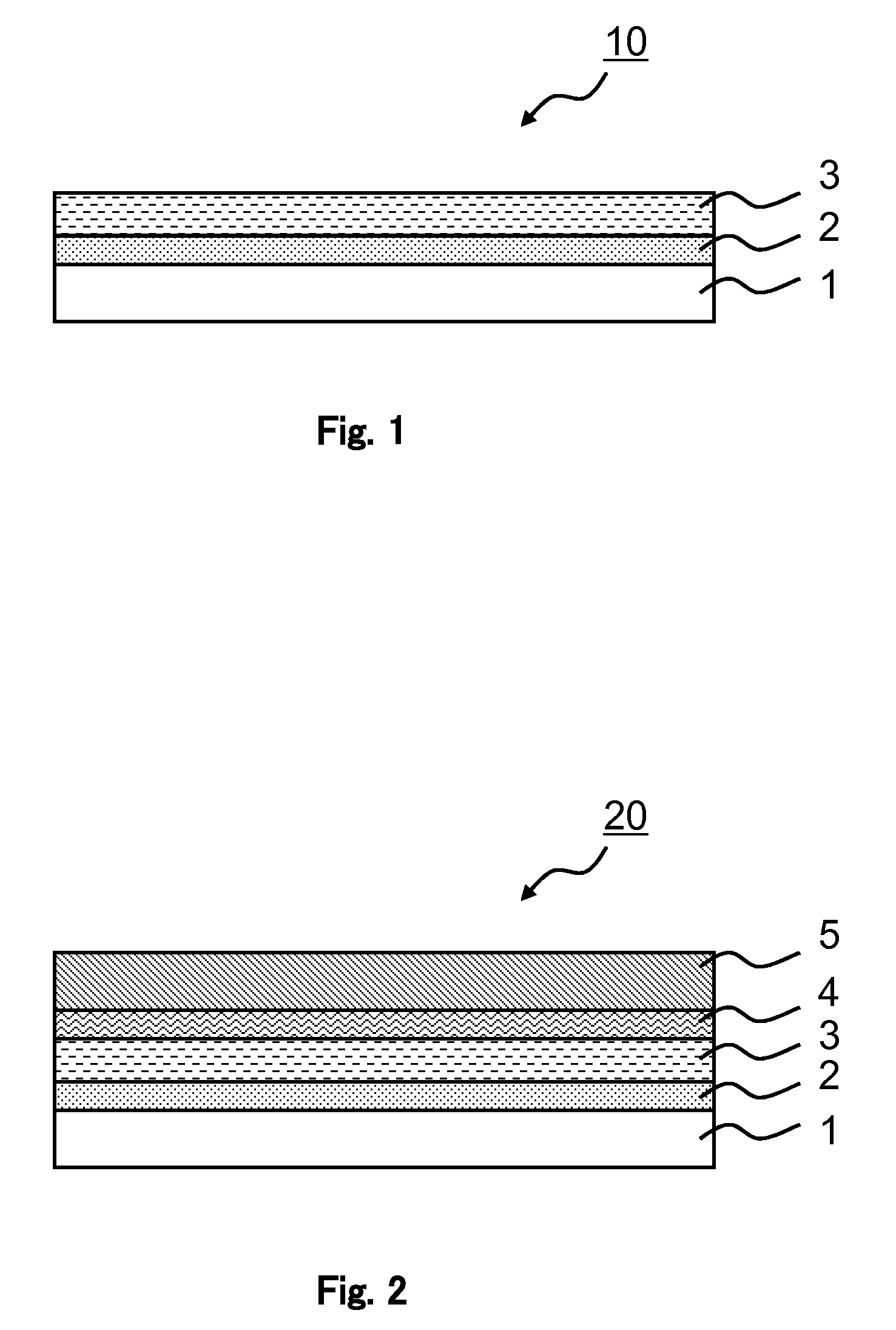Laminated body
a technology of laminated body and adhesive layer, applied in the field of laminated body, can solve the problems of low adhesion to the substrate, low printability and processing suitability, low adhesion, etc., and achieve the effect of reducing the degradation time of an adhesion between the substrate and the layer of fine cellulose fiber, ensuring coatability and adhesiveness, and reducing environmental load
- Summary
- Abstract
- Description
- Claims
- Application Information
AI Technical Summary
Benefits of technology
Problems solved by technology
Method used
Image
Examples
examples
[0094]Examples and comparative examples are described below. Incidentally, the present invention is not limited by these examples.
[0095]Bleached softwood pulp generally available was used as the cellulose.
[0096]60 g (weighed in terms of absolute dry mass) of the cellulose was added to 1000 g of distilled water, stirred to swell with water and fiberized by a mixer. Then, 2200 g of distilled water and a solution in which 0.6 g of TEMPO and 6 g of sodium bromide had been preliminarily dissolved in 400 g of distilled water were further added to initiate the oxidation reaction. Temperature was maintained at 20° C. or lower throughout the reaction. Although pH of the reaction system tended to decline while the reaction proceeded, the pH was adjusted to 10 by continuously adding 0.5 M of NaOH(aq). Four hours after the reaction started, the reaction was terminated by adding 60 g of ethanol. Subsequently, 0.5 M of HCl(aq) was dripped into the reaction liquid until it had a pH as low as 2. Th...
examples 1 to 9
[0116]25 μm thick PLA films which had undergone a corona treatment on the surface were prepared as the substrate. Each of the coating liquids 1 to 9 for forming an anchor layer was respectively coated on the corona-treated surface of the substrate by using a bar coater. Afterwards, the anchor layer with a thickness of about 0.2 μm was formed by drying the substrate at 60° C. for 20 minutes.
[0117]After the fine cellulose fiber dispersion liquid 1 was coated on the anchor layer by using a bar coater, a fine cellulose fiber layer with a thickness of about 0.2 μm was formed by drying it at 60° C. for 20 minutes.
[0118]Furthermore, a 70 μm thick polypropylene film, which was a thermoplastic resin film and was able to adhere by thermal welding, was pasted on the fine cellulose fiber layer by a dry laminating method using an urethanepolyol adhesive agent. As a result, a laminated body having a structure of “the thermoplastic resin layer / the adhesion layer / the fine cellulose fiber layer / the ...
examples 10 to 12
[0119]25 μm thick polyethylene terephthalate films which had undergone a corona treatment on the surface were prepared as the substrate. Each of the coating liquids 2 to 4 for forming an anchor layer was respectively coated on the corona-treated surface of the substrate by using a bar coater. Afterwards, the anchor layer with a thickness of about 0.2 μm was formed by drying the substrate at 80° C. for 20 minutes.
[0120]After the fine cellulose fiber dispersion liquid 2 was coated on the anchor layer by using a bar coater, a fine cellulose fiber layer with a thickness of about 0.2 μm was formed by drying it at 100° C. for 20 minutes.
[0121]Furthermore, a 70 μm thick polypropylene film, which was a thermoplastic resin film, was pasted on the fine cellulose fiber layer by a dry laminating method using an urethanepolyol adhesive agent. As a result, a laminated body having a structure of “the thermoplastic resin layer / the adhesion layer / the fine cellulose fiber layer / the anchor layer / the s...
PUM
| Property | Measurement | Unit |
|---|---|---|
| thickness | aaaaa | aaaaa |
| diameter | aaaaa | aaaaa |
| temperature | aaaaa | aaaaa |
Abstract
Description
Claims
Application Information
 Login to View More
Login to View More - R&D
- Intellectual Property
- Life Sciences
- Materials
- Tech Scout
- Unparalleled Data Quality
- Higher Quality Content
- 60% Fewer Hallucinations
Browse by: Latest US Patents, China's latest patents, Technical Efficacy Thesaurus, Application Domain, Technology Topic, Popular Technical Reports.
© 2025 PatSnap. All rights reserved.Legal|Privacy policy|Modern Slavery Act Transparency Statement|Sitemap|About US| Contact US: help@patsnap.com


